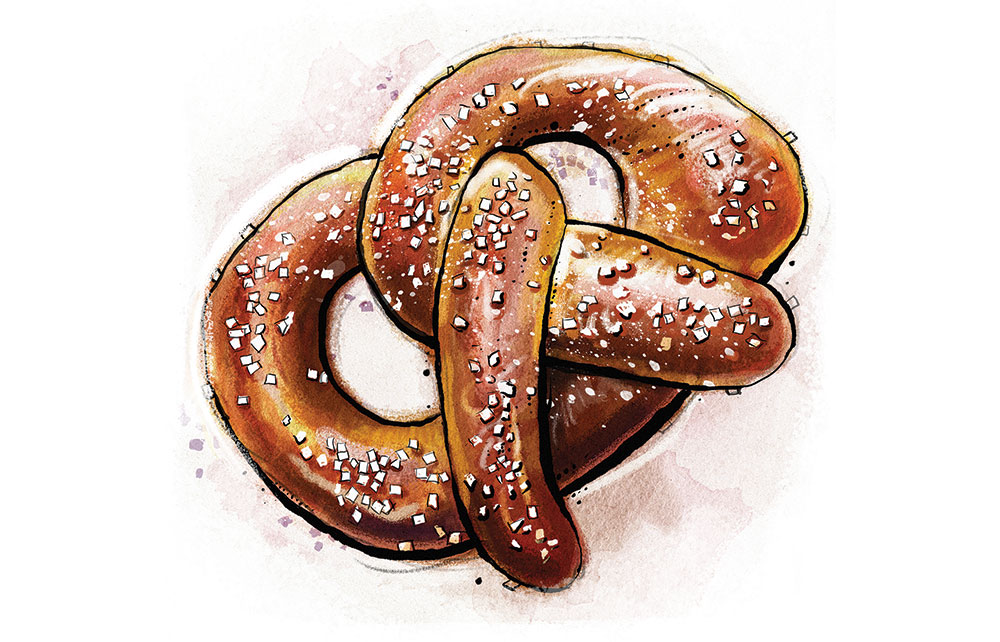My husband is obsessed with pretzels. The joy that a slightly warm, soft baked pretzel brings him is disproportionate. And, unlike in Germany and the States, where soft pretzels are ubiquitous, they are hard to come by here. So, for a while I have been trying to perfect the pretzel. It has not been smooth sailing.
Throwing your pretzels into a cauldron of water feels somewhere between heresy and madness
Pretzels are tricky: as well as being made from bread dough, and therefore yeasted, they are boiled before baking, have a very distinctive flavour, and their shaping requires a certain knack. Getting them right was a labour of love. But now I’ve cracked it, which means you should be able to avoid my pitfalls. I bake a lot, but the pride I felt when I removed my latest batch from the oven – mahogany gloss on the outside, pale and chewy within – was unparalleled.
The origins of pretzels are not certain – possibly they came to us from Christian monks, and they certainly became associated with both Lent and Easter – but they have been part of German baking traditions for centuries. Pennsylvanian Dutch immigrants introduced them to the US in the late 18th century and they spread across the country.
The most classic pretzel is made from a simple, yeasted bread dough, shaped into a knot, and flavoured simply with coarse salt on the top. The magic is in the contrast between the almost tangy roasty-toastiness of the dark brown crust, and the pale soft interior; a pretzel should be chewy inside and out. This is traditionally achieved by bathing it in lye after shaping and before baking.
Lye is sodium hydroxide, and a strong alkali, which alters the pH of the outside of the pretzel. But it is also corrosive and dangerous to breathe in. I am not going to ask you to source lye. The last time I used it was to clean an oven when moving out of a rented flat, and I gave myself burns all up my arms. Admittedly I was 22 and an idiot, but once chemically burned, twice shy.
The usual alternative to lye is bicarbonate of soda (often called baking soda in the US). This is a much weaker alkali that will have a similar if lesser effect once dissolved in water. It is possible to bake bicarbonate of soda to increase the alkaline level, but by doing so, you’re taking it closer to lye and its associated risks. Instead I favour normal bicarb, and a longer plunge of the dough into the bicarb solution.
Here comes the science bit. First the boiling gelatinises the starch; this fixes the pretzel’s shape, stops it from expanding very much in the oven and prevents the crust from becoming crunchy. Secondly, it deactivates (most of) the yeast, which results in a dense, chewy crumb. Finally, the bicarb (or lye) in the boiling water alkalises the outside which – as well as creating that beautiful hickory colour – gives the distinctive pretzel taste.
If you’ve never done it before, throwing your pretzels into a cauldron of water can feel somewhere between heresy and madness. It can also feel like you are going to undo all your good work. That beautiful dough! All your careful twisting! Fear not. Dipping the pretzels as soon as they’re shaped – rather than employing a second prove – retains their shape during the dunk.
And the knot-shaping itself is much easier than you might think. The key is to roll out each piece of dough to the correct length (about 70cm), and then leave each of them to relax just while you roll out the rest. This (short!) time will mean that when you come to shape them they won’t spring back. To shape: bring the ends of the dough together as if making a circle shape then, where the ends would meet, twist them twice and then flip the twisted ends over on to the base of the circle to create the iconic pretzel shape.
We eat these with classic American accompaniments: blue-cheese or French-onion dip, canary-yellow, American-style mustard, and a bowl of pickles. And, of course, a bottle of cold beer.
Makes 8
Takes 20 minutes, plus 2 hours proving time
Cooks 20 minutes
- 630g strong white bread flour
- 7g instant yeast
- 10g fine salt
- 20g butter, melted
- 1 tbsp malt syrup, or honey
- 350ml water, slightly warm
- 2 litres water
- 100g baking powder
- Flakey salt, to top
- Place the flour, yeast, salt, butter, malt syrup or honey and water in a large bowl or base of a stand mixer. Bring together into a dough and knead until the dough is elastic and starts to come away from the sides of the bowl. Cover and leave to prove for two hours.
- Turn the proved dough out on to a floured surface, and divide into eight equal portions. Roll each into a sausage shape. One by one, begin lengthening each sausage into a rope, letting the dough rest if it is pinging back, or struggling to stretch. Ultimately you want each rope to be about 70cm long.
- Take one dough rope and curve it round as if to make a circle; where the dough meets, cross the two ends over twice, and then flip the twisted ends downwards to sit on top of the curve, making the classic pretzel shape. Transfer the shaped pretzel to a lined baking tray. Repeat with all pieces of dough.
- Preheat the oven to 200°C. Bring two litres of water to the boil in a large pan, then add the baking powder. Lower each pretzel into the solution for 90 seconds, then transfer to a lined baking tray, and sprinkle generously with flakey salt.
- Bake for 20 minutes, then move to a cooling rack.
Sign up for Olivia Potts’s bimonthly newsletter, which brings together the best of The Spectator’s food and drink writing, here.







Comments